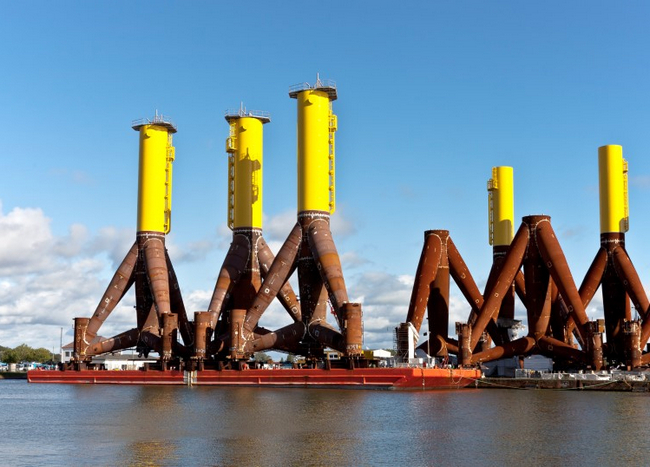A spin-off of the Bundesanstalt für Materialforschung und -prüfung (BAM) has developed a groundbreaking approach that revolutionises the welding process in the manufacture of steel towers for wind turbines. The new technology could secure important competitive advantages for the German wind industry and could also be used in the construction of hydrogen pipelines or liquid gas tanks.
In a modern steel wind tower, the welds add up to a length of about 700 metres. Steel sheets up to 30 millimetres thick have to be joined together in several layers using the so-called submerged arc welding process. At present, this takes a total of almost 100 hours. This alone limits the capacity of the four remaining German production sites to about 520 steel towers per year - only about half of what the German government's expansion targets for onshore wind energy envisage. Further steel towers are bought from abroad, mainly from China, where they can be produced particularly cheaply due to low labour costs.
Significantly faster - and at the same time more cost-effective - the systems could be produced using the laser hybrid welding process. It requires only a single welding layer. But so far, this process has only been approved for sheets up to 12 millimetres thick in industrial use. The reason: when welding thicker sheets, drops form from the liquefied metal underneath the weld seam due to gravity. They endanger the stability of the later plant and would have to be reworked at great expense.
A team from BAM's Competence Centre Wind has now found a smart solution to this long-known problem: The scientists have developed a system of electromagnets that is attached to the welding zone. The magnets release a so-called Lorentz force that counteracts gravity. This prevents any drop formation at the weld seam. At the same time, the system works completely contactless. The innovation makes it possible to use the faster laser hybrid welding process without compromising safety, even for the thick steel sheets used in wind turbines.
 With the help of electromagnets, the BAM start-up wants to reduce the welding time of a 120-metre wind tower from 96 to 12 hours. Cost savings of up to 90 per cent are possible as a result. Source: Gabriele Rohde/Adobe Stock
With the help of electromagnets, the BAM start-up wants to reduce the welding time of a 120-metre wind tower from 96 to 12 hours. Cost savings of up to 90 per cent are possible as a result. Source: Gabriele Rohde/Adobe Stock
Now the four scientists are setting up their own spin-off company. They want to develop their invention into a marketable system for industry in the next two years. They are supported by the EXIST funding programme of the Federal Ministry of Economics and Climate Action (BMWK). At the same time, they have access to the excellent research infrastructure of BAM, which has the most powerful high-power laser in Europe with 60 kilowatts.
According to Christian Brunner-Schwer, who is responsible for finance and sales in the team, the potential time and cost savings from the innovation would be enormous for a modern 120-metre wind tower: by using laser welding, which the magnet system makes possible, the welding time could be reduced from 96 to just under 12 hours - an acceleration by a factor of 8. At the same time, only 900 instead of 4000 kilowatt hours of energy would be needed. The costs for welding could be reduced by a total of 90 per cent. The CO2 emissions from the production of a wind tower would even be reduced by 93 per cent.
"Experts already confirm that our system could become a game changer for the wind industry," explains Fatma Akyel, who is responsible for research and development in the team. "At the same time, steel wind towers are only one field of application for our innovation. There is further potential wherever, thick-walled steel sheets are joined together: in the construction of hydrogen pipelines, of containers for liquid gas or chemicals, in ship and bridge construction."
